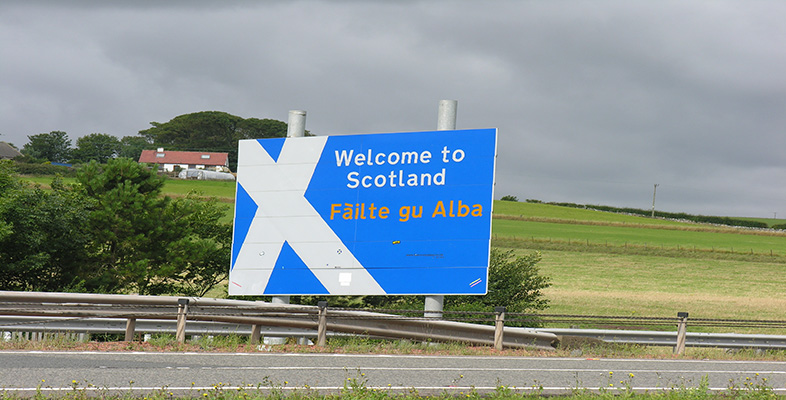1.4 Retreat into the north and west
By the end of the 15th century, the Inglis speech of the south-east was being referred to by its speakers as ‘Scottis’, indicating that Lowland Scots, while speaking a language closely related to that of their English neighbours, were Scottish in identity. Scots and Gaelic borrowed vocabulary from each other, as did Scots and Norse, and Gaelic and Norse.
Examples of words which entered Gaelic from Scots are bodhaig (from bouk, a body), dìg (ditch), eàrlas (arles, a pledge, token), poca (pock, poke, a bag) and radan (rattan, a rat). Scots words which derive from Gaelic include ben (beinn, a mountain), claymore (claidheamh mòr, a big sword), corrie (coire, a cauldron shaped bowl in the mountains), ghillie (gille, a servant), kyle (caol, a narrows), machair (machair, a plain) and whisky (uisge-beatha, water of life).
But, despite Gaelic’s status as a founding language of Scotland, Lowland writers started to refer to it as Irische or Ersch. This is seen in the famous poetic ‘Flyting of Dunbar and Kennedy’, written in Scots in around 1505, in which Lothian-born William Dunbar pours scorn on the Gaelic-speaking Walter Kennedy for being Heland and an Ersch Katherane (ironically using a word derived from Gaelic) whereas Kennedy tells Dunbar that Gaelic is all trew Scottismennis leid (all true Scotsmen’s language) and suggests that the latter would be happier living in England.
Kennedy, a significant and well-connected figure, was not from the Highlands at all, but from Carrick. This area and neighbouring Galloway remained Gaelic-speaking (their dialect is known as Galwegian Gaelic) long after the language had retreated from the rest of southern mainland Scotland, probably well into the 17th century. The dialect in nearby Arran, which was probably similar to Galwegian Gaelic, survived until the 20th century.
Dunbar’s disdain towards Kennedy’s Gaelic roots in Carrick (modern Ayrshire) is clear in the following stanza:
Sic eloquence as thay in Erschry use, In sic is sett thy thraward appetyte. Thow hes full littill feill of fair indyte. I tak on me, ane pair of Lowthiane hippis Sall fairar Inglis mak and mair perfyte Than thow can blabbar with thy Carrik lippis. | Such eloquence as they in Irishry [Gaeldom] use Is what defines your perverse taste. You have very small aptitude for good verse-making. I'll wager, a pair of Lothian hips Shall fairer English make and more polished Than thou can blabber with thy Carrick lips. |
During the late 16th century, it is reckoned that half of Scotland’s population lived north of the Tay and a very large number of them spoke only Gaelic. Their language, way of life and tendency to be less than fully loyal to the Edinburgh-based monarch were an affront to King James VI, who embarked on a programme to unify the nation by turning his subjects into a monoglot English-speaking people. He attempted to break the power of the Highland clans and to plant Lowlanders in Gaelic-speaking areas, although he was notably unsuccessful in Lewis, where a band of would-be settlers, known as the Fife Adventurers, were forcibly resisted.
Following the union of the Crowns of Scotland and England in 1603, the king (now James I of England) felt emboldened to press his case for the eradication of the Gaelic language. In the Statutes of Iona (1609) he forced clan chiefs to send their eldest child to school in the Lowlands in order to anglicise them, and an Act of the Privy Council9 on 10 December 1616 expresses the desire that the ‘vulgar Inglishe toung be universallie plantit, and the Irische language … may be abolisheit and removeit’. The Act promoted the establishment of English-language schools in every parish, regardless of linguistic heritage.
It has been estimated10 that Gaelic was spoken by some 290,000 people, 23 per cent of Scotland’s population, in 1755. The total was down slightly to 254,000 in 1891 but by then this represented only 6.8 per cent of the national population. Gaelic was by now very much a minority language nationally although still very strong locally in much of the rural Highlands and Hebrides.
